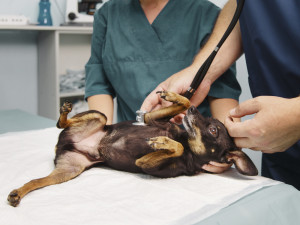Are Hops Poisonous to Dogs?
If you’re home brewing beer, beware of this highly toxic bitter plant.

share article

Your pet wants you to read our newsletter. (Then give them a treat.)
Home-brewing is a trend that is becoming more and more popular, and unfortunately, so is the occurrence of hops poisoning in dogs. Humulus lupulus, more commonly known as Hops, is the plant used in the process of brewing beer. The mechanism of hops toxicity in dogs is unknown, but may be related to essential oils, resins, phenolic compounds, or nitrogenous constituents within the plant. Many of the substances in hops are degraded or aerosolized during the brewing process, so the exact relationship between substance and toxicity remains unknown.
Hops are extremely dangerous to pups both before and after they are used in brewing, however raw hops are fairly bitter, so dogs are less likely to consume them compared to spent hops. True flowers or dried hops plugs tend to be more toxic than hops pellets (pellets have less residue), while wild hops have been found to be non-toxic.
Veterinarians will typically diagnose hops poisoning in dogs based on the pet parent’s history of having home-brewing supplies as well as seeing hops in vomit.
Symptoms of Hops Poisoning in Dogs
Agitation
Panting
Excitement
Flatulence
Rapid heart rate
Anxiety
Seizures
Vomiting
Life-threatening elevations in body temperature (above 105⁰ F)
Death has been reported in as little as 6 hours without appropriate treatment. I have seen rectal temperatures greater than 108⁰ F, and these temperatures can be very difficult to control. The high end of normal of a dog’s temperature is 102.5⁰ F, and any temperature above 106⁰ F can lead to an “unwinding” of the body’s proteins as well as permanent brain injury, depending upon the length of time that the elevation in body temperature persists.
Treating Hops Toxicity in Dogs
Treatment consists of aggressive decontamination measures, including induction of vomiting, gastric lavage (“washing out” the stomach under anesthesia), administration of charcoal, and enemas. Active cooling by any means available is extremely important. There are also specific medications that can be given in the hospital to help control the symptoms.
If you suspect your dog has been exposed to hops, seek veterinary care immediately. This is not something that can be managed at home. Quickly take a rectal temperature, and if it is found to be greater than 105⁰ F, begin active cooling measures—such as dousing your pet’s body with cool water and wrapping icepacks in towels and placing them over their body—in addition to running the air conditioning in car while on your way to your veterinarian or local emergency clinic. This measure could help save your pup’s life and give them the best chance for survival.
The prognosis for survival of hops toxicity is generally guarded to poor, and unfortunately, many deaths have been reported. I’ve seen two cases of hops toxicity in dogs this past year in the ER, and thankfully, both survived with aggressive treatment.
Are Some Dog Breeds at Higher Risk?
Any breed of dog may be affected, but breeds that are predisposed to malignant hyperthermia (extreme elevation of body temperature for an unknown reason) tend to be more susceptible. These breeds include Greyhounds, Labrador Retrievers, Saint Bernard’s, Pointers, Dobermans, Border Collies, English Springer Spaniels, and those in the northern breeds group.

Dr. Shea Cox, DVM, CVPP, CHPV
Dr. Shea Cox is the founder of BluePearl Pet Hospice and is a global leader in animal hospice and palliative care. With a focus on technology, innovation and education, her efforts are changing the end-of-life landscape in veterinary medicine.
Related articles
![A dog getting checked out at the vet]() opens in a new tab
opens in a new tabWhat to Expect At the Emergency Vet
It's every pet parent's nightmare — but knowing what happens when you take your dog to the ER can make the experience a little less stressful.
![A dog laying down looking sad.]() opens in a new tab
opens in a new tabVets Are Seeing a Rise in “Pot Puppies”
You aren’t the only one getting way too high from edibles. A study published on 4/20 found an uptick in cannabis poisonings in pets.
![Black cat with white spots on its fur laying on a light blue blanket while wearing a con around its head]() opens in a new tab
opens in a new tabBe Prepared: Four Pet Emergency Room Essentials for Pet Parents
Lay the groundwork for quick, low-stress treatment.
![shy dog frightened in the arms of the owner. this brown mixed-breed hound puppy has a sweet gaze. the female owner has a wool sweater]() opens in a new tab
opens in a new tabWhy is My Dog Shaking? Causes and Treatment
A vet explains why the weather isn’t always to blame.




